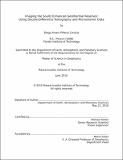| dc.contributor.author | Concha, Diego Alvaro Pinero | |
| dc.contributor.other | Massachusetts Institute of Technology. Earth Resources Laboratory | en_US |
| dc.date.accessioned | 2012-01-13T19:16:34Z | |
| dc.date.available | 2012-01-13T19:16:34Z | |
| dc.date.issued | 2010-06 | |
| dc.identifier.uri | http://hdl.handle.net/1721.1/68579 | |
| dc.description.abstract | We applied the double-difference tomography method to image the P and S-wave
velocity structure of the European Hot Dry Rock geothermal reservoir (also known
as the Soultz Enhanced Geothermal System) at Soultz-sous-Forets, France. We used
absolute, differential catalog and differential cross-correlation times obtained from
the reservoir’s September and October 1993 hydraulic stimulations along with
starting event locations obtained using Joint Hypocenter Determination and
Collapsing methods. The stimulations produced over 12000 microseismic events of
which we chose 8930 for further analysis. We obtained high accuracy crosscorrelation
differential times and then performed a double-difference tomographic
inversion to jointly invert for velocity structure and event locations.
It is shown through a detailed analysis of model and data residuals vs smoothing
weight, ray path derivative weighted sums, and a synthetic checkerboard test that
the double-difference inversion is able to produce interpretable results despite the
poor source-receiver geometry employed in the study.
The results show that velocity structure for S-waves correlates well with seismicity
and show the expected low velocity zones at depths between 2900 and 3600
meters, where fluid was believed to have infiltrated the reservoir. P-wave velocity
structure shows less of a correlation with seismicity and shows low velocity zones at
shallow depths where no water was believed to have entered the reservoir. Between
2900 and 3600 meters the P-wave velocity structure shows high velocity zones near
the injection well. The results also show the NNW-SSE trend of event location
clusters and velocity structure which lines up with the maximum horizontal stress
orientation. Lastly, we show that using the double-difference tomographic method
to relocate events produces locations that come close to rivaling those of collapsing
methods. | en_US |
| dc.publisher | Massachusetts Institute of Technology. Earth Resources Laboratory | en_US |
| dc.relation.ispartofseries | Earth Resources Laboratory Industry Consortia Annual Report;2010-04 | |
| dc.subject | Tomography | |
| dc.subject | Microseismic | |
| dc.subject | Geothermal | |
| dc.title | Imaging the Soultz Enhanced Geothermal Reservoir Using Double-Difference Tomography and Microseismic Data | en_US |
| dc.type | Technical Report | en_US |
| dc.contributor.mitauthor | Concha, Diego Alvaro Pinero | |
| dspace.orderedauthors | Concha, Diego Alvaro Piñero | en_US |
